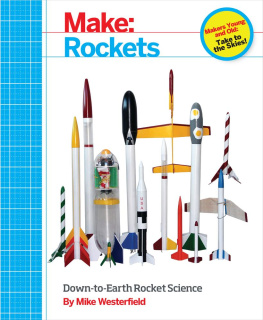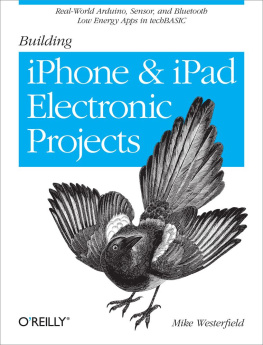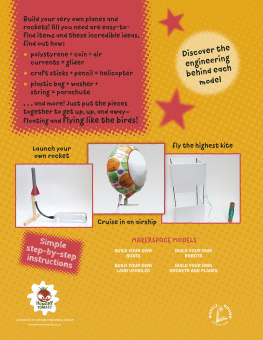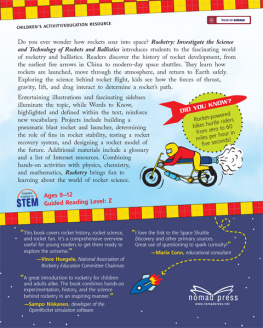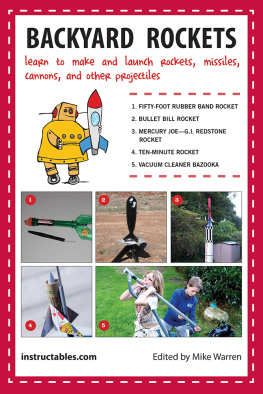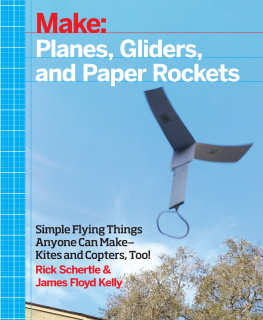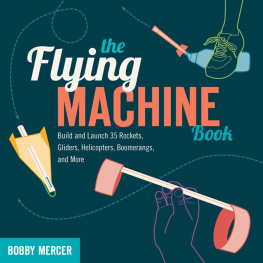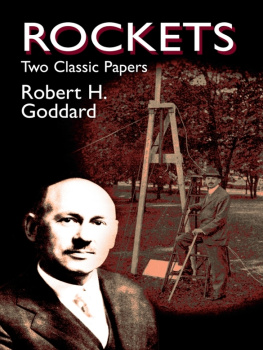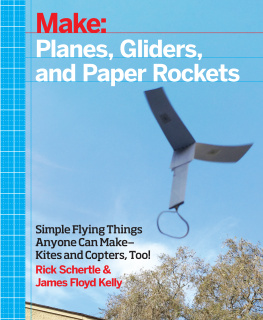Make: Rockets
Down-to-Earth Rocket Science
Mike Westerfield
Preface
Model rocketry has had a profound impact on my life, and I hope it does on yours, too. If you are associated with education, youve probably heard the term STEM tossed around. It stands for Science, Technology, Engineering, and Mathall those skills we as a nation are trying to promote. Model rocketry is the perfect STEM hobby. Let me share how it changed me.
While I have always been bright, some might argue precocious, I was a more or less average student through most of my early education. I did well enough in science and math to be placed in the advanced classes, but generally didnt work hard enough to excel. The classes simply didnt interest me much. Who cared that a screw was an example of a wedge, one of the basic tools? Seriously? That was science? Why would I bother?
Around the time I turned 14, I started building and flying model rockets. I read everything I could find on how they flew and how to make them fly higher and faster. As a sophomore in high school, I was cruising along with a 2.3 or 2.4 grade point average. I got interested in what I thought was a simple problem: how high would my rockets go?
That summer I took an algebra book home. I came back the next fall and tested out of second-year algebra. I enrolled in physics, devouring the book, working every problem, not just the ones that were assigned. My GPA that year was 3.7. It was 4.0 my senior year. I won an appointment to the United States Air Force Academy, where I majored in physics. Upon graduation, my first assignment was as the resident physicist for a classified satellite program. I was, quite literally, a rocket scientist. Four years later I earned an MS in physics, and finally felt I had answered that problem I started on when I was a sophomore in high school. I could determine how high my rockets would go to my satisfaction.
Now Im not saying model rockets will turn every underachieving sophomore into a rocket scientist. Even if it would, we dont need that many rocket scientists! I introduced both of my daughters to model rocketry, along with about a dozen fifth-grade classes over the years. Neither of my daughters is a rocket scientist. One is a special education teacher; the other is a research scientist working on cancer vaccines. My granddaughter is seven; she has been flying rockets on and off since she was two, and could push the launch button. She may not end up being a rocket scientist, either, but she will still see a little more about what all those math and science classes can be used for. At the very least, she still likes science, and comes over to play with the toys regularly. Her current specialty is polymersshe loves learning how they mix and react, especially the ones that change state or swell with water.
Taking a look at my life and those of many of my friends, we got different things from rocketry at different times in our lives. This book is written to let you get different things out of it, too, whether you are reading it for yourself, as a teacher or parent helping out an interested child, or as an adult taking up a new hobby.
For younger children, say ages 8 to 15, most of the math and a lot of the science in this book will be too advanced. Skip it. You can build and fly all of the rockets and launchers without digging into any of the math, and with little or no understanding of the science. After all, rockets are fun to build and fly. This book will show you how to build solid propellant rockets, water rockets, and air rockets. Youll see how to build launchers for each type of rocket and how to track them to see how high they go. Youll learn to build high-performance rockets that can hit 500 mph and fly a half mile into the sky, and experience the thrill of seeing a rocket glider roar into the air and glide safely back to earth.
As children become young adults, say ages 14 to 18, they rapidly pick up new skills in math and science. While some of the math may still be a bit too advanced, most isnt. Very simple trigonometry shows how to track the altitude of a rocket. Basic principles of physics and aeronautical engineering explain how rockets fly and what makes them stableor unstable! Simple computer programs or free rocket simulators let budding scientists safely design and build their own rockets, showing which designs will fly well. They also do a great job of telling you how high a rocket will go. Most of the math, most of the science, and all of the computer programs are well within reach for high school students. This is the stage when browsing through the book will either answer your questions or give you a good start on finding the answers.
Model rocketry is a hobby for a lot of adults, too. As you make your way into college and take ever more advanced classes in calculus, physics, electrical engineering, and aeronautical engineering, you will find fun projects in this book. Thats when youll dive into the more advanced parts of the book. Basic electrical engineering explains why launchers are designed as they are. Computer programs and simulations combined with aeronautical engineering help you coax the most from a particular model rocket design. You will push beyond some of the information in this book. Perhaps you will design your own GPS device, use high-powered rockets to explore trans-sonic flight, build sensor packages to track the speed and altitude of a rocket, or design control mechanisms to keep a rocket from twisting so it is a better platform for photographyall projects that have been worked on by members of the local rocketry club I belong to. By now, you can handle anything in this book. It will give you a basic understanding, although youll almost certainly jump off to more advanced material in physics, math, electrical engineering, mechanical engineering, computer science, and aeronautical engineering to satisfy the particular projects you find interesting.
So whether you are just getting started with model rocketry or are an experienced hobbyist looking for ways to sharpen your skills for a contest, this book will help you reach your goals. Whether you end up with a career in space exploration or not, youre about to become a rocket scientist!
Conventions Used in This Book
The following typographical conventions are used in this book:
Italic Indicates new terms, URLs, email addresses, filenames, and file extensions. Constant width Used for program listings, as well as within paragraphs to refer to program elements such as variable or function names.
This icon signifies a tip, warning, or general note.
Safari Books Online
Safari Books Online is an on-demand digital library that delivers expert content in both book and video form from the worlds leading authors in technology and business.
Technology professionals, software developers, web designers, and business and creative professionals use Safari Books Online as their primary resource for research, problem solving, learning, and certification training.
Safari Books Online offers a range of plans and pricing for enterprise, government, education, and individuals.
Members have access to thousands of books, training videos, and prepublication manuscripts in one fully searchable database from publishers like OReilly Media, Prentice Hall Professional, Addison-Wesley Professional, Microsoft Press, Sams, Que, Peachpit Press, Focal Press, Cisco Press, John Wiley & Sons, Syngress, Morgan Kaufmann, IBM Redbooks, Packt, Adobe Press, FT Press, Apress, Manning, New Riders, McGraw-Hill, Jones & Bartlett, Course Technology, and hundreds more. For more information about Safari Books Online, please visit us online.

